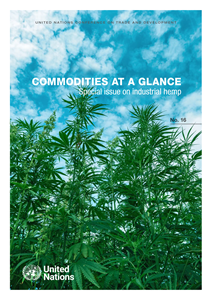NHA works to break down global barriers for industrial hemp
Report Cover


Washington D.C., Dec. 01, 2022 (GLOBE NEWSWIRE) — National Hemp Association has been engaged with United Nations, FAO, International Fund for Agricultural Development (IFAD), and World Bank to advance the recognition and acceptance of industrial hemp around the planet.
“We are pleased that the UN Conference on Trade and Development invested in creating this special issue on Industrial Hemp. It is a tremendous step in breaking down barriers for the hemp industry”, said Geoff Whaling, Chair of the National Hemp Association.
This report discusses the general uses of industrial hemp and how they are reflected in international production and trade statistics. Based on current practical experiences and empirical expertise, it also defines the steps that could be taken by developing countries where climate and agronomic characteristics are favorable for its cultivation to take advantage of its economic and social potential.
A whole-plant approach should be at the core of any sectoral development strategy. This approach could facilitate the creation of production chains that are able to contribute to growth in rural areas, in manufacturing and in the food processing industry.
To fully exploit the potential of industrial hemp, countries would need to take specific actions. For instance, a clarification of the legal status of hemp as distinct from intoxicant cannabis substances could be the first step taken by governments.
A precise understanding of production constraints imposed by regulatory frameworks in destination markets would also be necessary to identify market potential. Regional cooperation to facilitate the establishment of production chains may also be a strategy for developing countries to consider.
This report is organized as follows:
Chapter 2 presents the definitions and taxonomy related to the Cannabis L. genus, followed by a description of its botanical properties and ecological characteristics.
Chapter 3 discusses the industrial hemp sector value chain. It first describes production options and constraints faced by major growers. It then looks at potential challenges and opportunities for processors. Finally, the chapter considers how consumers’ preferences, and their evolution, may affect market trends.
Chapter 4 first presents some facts and figures about hemp production, followed by information relating to international trade in hemp products. The last section discusses tariffs and NTMs relating to hemp trade.
Chapter 5 discusses prices of industrial hemp products, based on trade unit values and prices that are published by the Food and Agricultural Organization of the United Nations (FAO) and various other sources.
Chapter 6 highlights policy issues for consideration by governments for promoting the development of industrial hemp.
This establishes a framework for US hemp fiber and grain growers to sell into the international marketplace. National Hemp Association works around the globe to assist nations in adopting legislation and regulations.
About the National Hemp Association:
NHA is rooted in the knowledge that hemp can provide a wide range of opportunities, from field to factory, and has a global Total Addressable Market (TAM) of 15 trillion dollars. Hemp has an important role to play in creating a better and more sustainable future and for hemp to reach its potential, we advocate for sensible public policy and regulation. We are also facilitators in building reliable supply chains by seeking out others we can work with to further our mutual objectives as well as connecting people and businesses to help them reach their individual and collective goals.
NHA is a Grass Roots Advocacy organization celebrating our 10th anniversary in 2023! www.nationalhempassociation.org
Attachment
CONTACT: Erica Stark National Hemp Association 202-706-3911 erica@nationalhempassociation.org Geoff Whaling National Hemp Association geoff@nationalhempassociation.org






